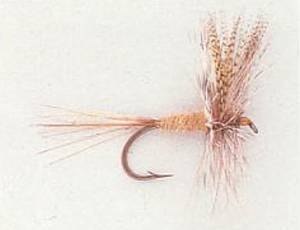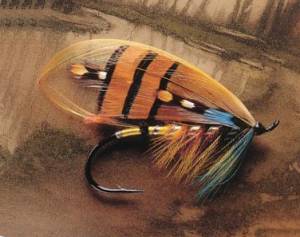| Home Page
Shop History
Fly Tying
Trout Catalogue
Salmon Catalogue
Hunting Accessories
Archery Services
Log Cabin
Cabinets
Various Projects
Archery Links
My Links
|
|

Are you tired of the continuing rising prices and dependability of commercially tied flies? Leave the middle man out! Take advantage on savings and durability of hand tied flies.
As the hobbyist is not bound nor restricted by quantity and tight scheduling of mass production. Greater care is taken in the choice of materials and tying techniques in producing a better quality and more durable product. That's right you can fish these flies!
The patterns I use are provided by: the Orvis Index of Fly Patterns; renown tiers Dick Stewart, Lee Wulff and Jack Dennis, the latter is best known throughout the Flyfishing Community for his Western Trout Flies.
Although, hairwing dry flies are slightly more expensive, their durability and the fashion in which they "ride the water", make them a good investment. These statements hold especially true when, fished in fast moving waters.
It is for these reasons that I have chosen Jack Dennis's techniques in tying dry flies my specialty.
Sincerely your's....
Rick (Moe) Moquin
Dry Flies
Traditional: Many fisherman favour fishing the dry fly technique, to experience the excitement of seing the trout rise to the fly. Often hunting for the big trout feeding on the surface.
Wulff Series: Wulff patterns are unsurpassed in floatability, durability and attractiveness to trout. Hairwings, tails and lots of hackle provide buoyancy, so you can concentrate more on dry fly fishing and less time keeping your fly afloat.
Goofus bugs (Humpy) Series: With their hairwings, tails and bodies, "goofus bugs" float even better than the Wulff Series, thoughnthey are slightly less durable. The deer body hair is pulled back over the hook shank and tied down. Forming a "buggy looking" bump or case. The body colour shows as a stripe under the body hair.
Deer Hair Series: Besides being very attractive to trout, the spun, clipped deer hair bodies are extremely durable and make these flies float like a cork.
Kozler Firefly Series: Like the Wulffs, these flies have hairwings and tails. A hackle palmered over their fluorescent bodies make them even more buoyant. A Kozler can be an especially good choice when you need a high floating, bushy dry fly that is easy to see under low light conditions.
Parachute Series: Parachute flies have a single, upright wing of white hair. The hackle is wound around the base of the wing which, causes the fly to lie in the plane of the water surface. Like their name suggests Parachute Flies light on the water like natural Mayflies do. Parachutes are extremely easy to see under low light conditions.
Trude Series: These flies have a white hairwing tied down over the body, much like short bucktail streamer wings. Trudes are good caddis immitations and their white wing make them easy to see, on or below the surface. Some anglers prefer Trudes to Wulff Style dry flies.
Elk Hair Series: Al Troth's Elk Air Caddis is a versatile caddis immitation and an excellent floater due, to it's palmered body. When you want to fish a dry caddis through riffled areas, this pattern is a good choice.
Terrestrial Series: In late summer, it is often easier to take trout on terrestrials, than on a fly that matches whatever hatch in progress. Many times during the hatch when the fish are fussy a terrestrial will take them.
Wet Flies
Traditional: Although, wet flies have largely been replaced by the Nymph Patterns, they were at one time the only flies fisherman used. Fished accross current and retrieved with short strips, they were very effective. If you have not been using Wet Flies, you may find you have been missing a good bet when, you do not see fish feeding on the surface.
Nymphs: A trout's diet is made up mostly of nymphs. Weighted nymphs work well anywhere Mayfly hatches occur.
Woolly Buggers: This fly is renowned for it's ability to attract big trout in big water. But, can be equally effective in small streams when trout are feeding selectively. The Marabou tail together with soft palmered hackle, give the Woolly Bugger enticing action.
Muddler Minnows: Fished wet or dry, the Muddler Minnow was meant to imitate bait fish. Which, it does extremely well. However, many anglers dress the Muddler to float and use it to imitate grass hoppers and other insects. No matter how you fish it, you will find the Muddler effective on almost any fish that will take a fly.
Marabou Muddlers: Marabou Muddlers are consistent producers of large trout. The Marabou pulses in the water, giving these flies a very lifelike appearance. Marabou Muddlers are also very effective for fishing bass.
Bucktail Streamers: These flies have stood the test of time and have proven their effectiveness over the years. They are extremely durable and most important of all they catch trout. No angler should be without them.
Matukas: Matukas are the modern pattern for streamers. The feather wing is tied down along the back, giving the flie a minnow effect. When stripped through the water, the fly pulsates, attracting aggressive trout.
$$$ My Prices $$$
Salmon Singles: $ 20.00 Doz......$ 2.00 ea
Salmon Classics: $ 45.00 Doz......$ 4.50 ea
Salmon Glitter Bugs: $ 25.00 Doz......$ 2.50 ea
Salmon Bugs & Muddlers: $ 22.00 Doz......$ 2.25 ea
Bombers: $ 27.00 Doz......$ 2.75 ea
Hairwings & Wulffs: $ 22.00 Doz......$ 2.25 ea
Streamers: $ 20.00 Doz.....$ 2.00 ea
Bucktails: $ 18.00 Doz.....$ 1.75 ea
Terrestrials: $ 15.00 Doz.....$ 1.50 ea
Trout Parachute: $ 13.00 Doz.....$ 1.25 ea
Trout Regulars & Nymphs: $ 10.00 Doz.....$ 1.00 ea
Bass Bugs: $ 32.00 Doz.....$ 3.25 ea
When placing you order please specify quantity and sizes desired. Otherwise, flies will be tied using standard preferred sizes. Thank You...
I also offer assortment packages. Take advantage of these special values. Drop me an e-mail for more info or visit either the trout/salmon catalogue.
 

|
|
|
|


